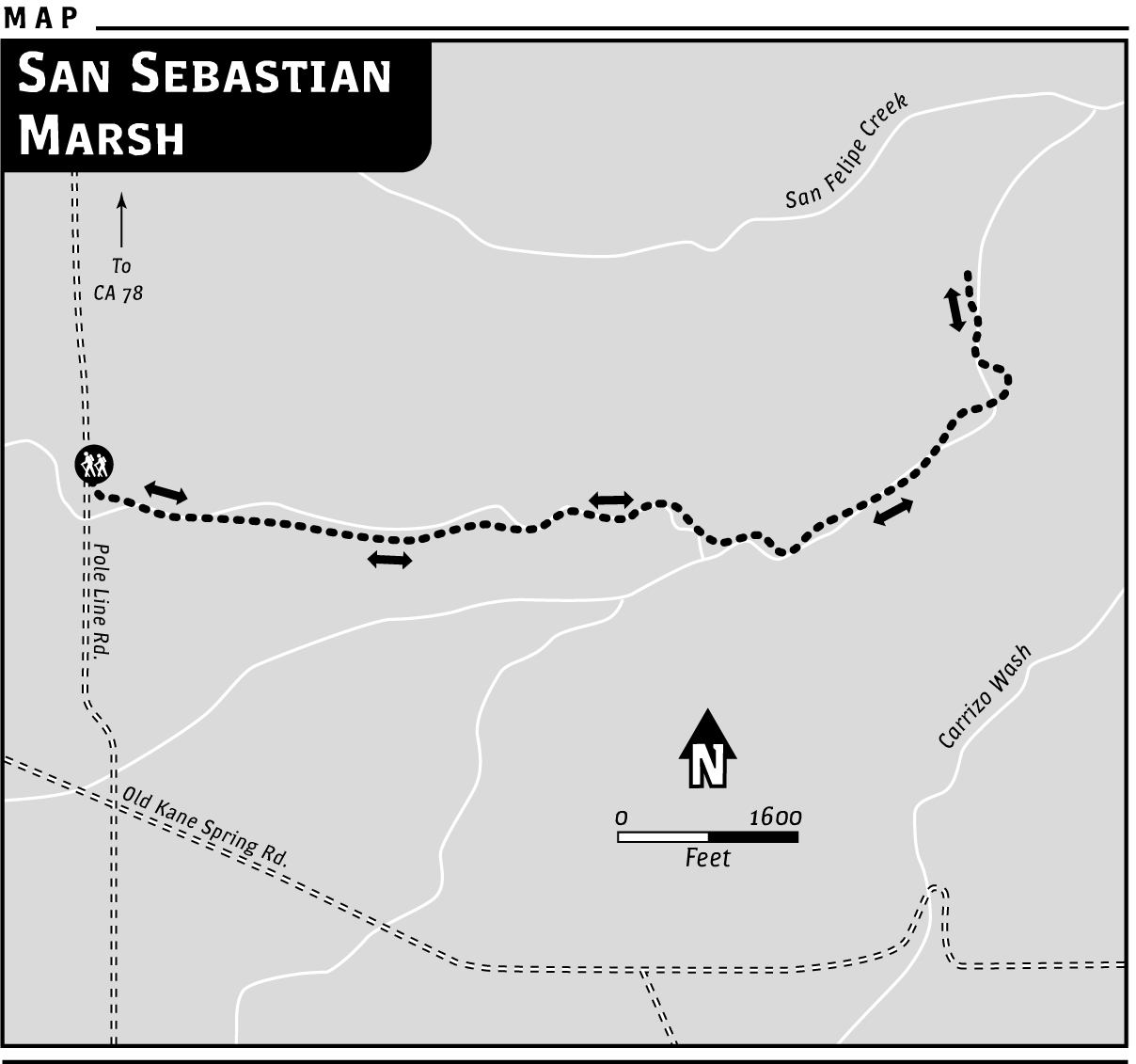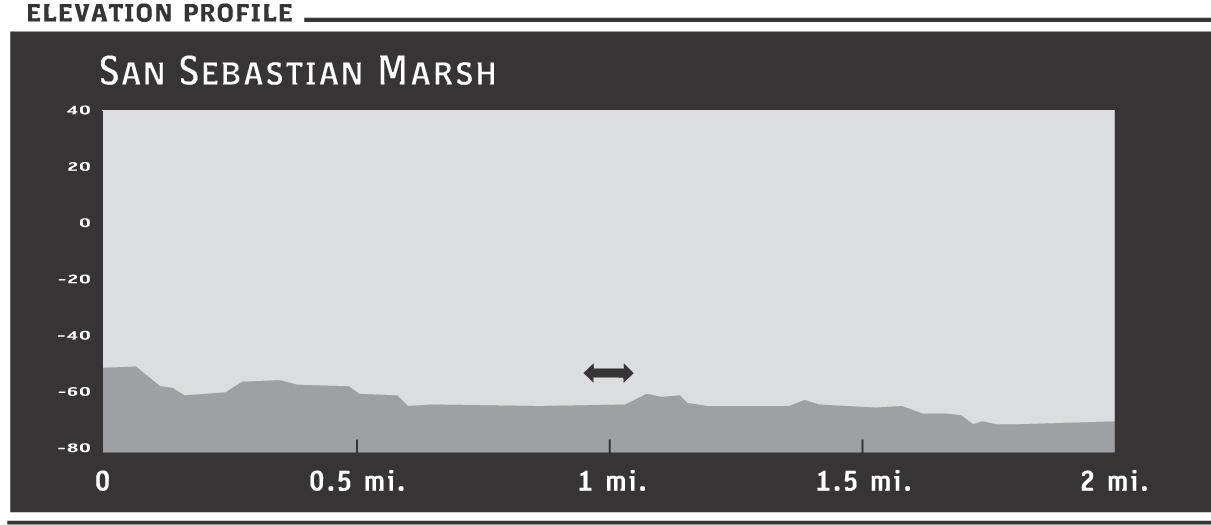28 San Sebastian Marsh
SCENERY: 
DIFFICULTY: 
TRAIL CONDITION: 
SOLITUDE: 
CHILDREN: 
DISTANCE: 4 miles round trip
HIKING TIME: 2 hours
OUTSTANDING FEATURES: Soft, sandy wash; water; shells; seabirds; tamarisk; and open desert views
This fairly short hike along the etched channel at the terminus of Fish Creek Wash delivers you from the arid desert air to the refreshingly moist breezes and riparian environment of San Sebastian Marsh. Listed mileage is typical of mid- to late spring, but will vary year-to-year with the weather. The marsh forms where Fish Creek, Carrizo, and San Felipe washes meet.
Directions: On CA 78, continue east approximately 9 miles past Ocotillo Wells. At the fenced San Felipe Electrical substation, turn right on Pole Line Road (dirt). Continue south, with vehicle-restricted BLM land on either side, for approximately 3.2 miles. Park at the deeply etched Fish Creek Wash.
| GPS Coordinates | 28 SAN SEBASTIAN MARSH | |
| UTM Zone (WGS84) | 11S | |
| Easting | 595391 | |
| Northing | 3660664 | |
| Latitude–Longitude | N 33º 4’ 49.4108” | |
| W 115º 58’ 40.6032” |


 After parking your vehicle above deep Fish Creek Wash, move on foot down into the gully and begin walking east (left). You may see and hear motorcyclists from nearby Ocotillo Wells, but you’ll be heading into BLM land deemed an “Area of Critical Environmental Concern” and therefore off-limits to vehicles. Occasionally, motorcyclists ignore rules, so do be aware of the sound of engines heralding the presence of approaching riders on ATVs.
After parking your vehicle above deep Fish Creek Wash, move on foot down into the gully and begin walking east (left). You may see and hear motorcyclists from nearby Ocotillo Wells, but you’ll be heading into BLM land deemed an “Area of Critical Environmental Concern” and therefore off-limits to vehicles. Occasionally, motorcyclists ignore rules, so do be aware of the sound of engines heralding the presence of approaching riders on ATVs.
As you move along the bottom of Fish Creek Wash, hidden from the open desert beyond its sandy walls several feet higher than your head, you’ll feel isolated. The din of civilization will ebb, leaving only your thoughts and the rhythmic crunch of sand and dried mud beneath your feet.
In springtime, purple-pink sand verbena dots the landscape with color, often disbursed in clumps. The plants huddle together, forming small communities busy with insects—bees, ants, and beetles. Tamarisk, a non-native tree that’s considered invasive and often targeted in San Diego–area removal efforts, also grows here. For the moment, forget its negative status and enjoy the blessings it provides—spots of shade and pretty pink bloom tufts swaying softly in the breeze.
Typically, by mid- to late spring, the first mile of the trek is fairly dry. Baked by the sun, mud dries in puzzle-piece patterns, the topmost layer curling. Beneath your feet, paper-thin surface curls crunch like potato chips. Bigger, thicker mud curls, created where water pooled for longer periods, give way more slowly, their sound like ceramic chimes. Mud that has dried in stages, creating tissue-thin layers that cling together in an inch-thick group, sound like rumpled cellophane.
In the dense quiet of this sun-dried terrain, listen for subtle nuances, like music you create with each step. Sand, kicked up by wind, frosts some of the dried mud curls, its weight muffling the crunch beneath your feet. Other mud cracks in big, long sheets the shape of continents, while still more pieces curl so much they close in on themselves, forming tubes—all making unique melodies as you tread.
The rhythm of your footsteps may lull you, but don’t get too comfortable. The route becomes progressively moister, so be careful where you step. The dried surface may be hiding an underlayer of slippery mud that can send you reeling.
What may at first appear as a frosting of salt in spots is, upon closer examination, actually multitudes of tiny shells left behind as water receded. These remnants of life demonstrate the abundance of water here near the terminus of Fish Creek Wash, which expands or decreases the boundaries of San Sebastian Marsh with changing weather.
After 1.5 miles (or perhaps sooner in wetter years or earlier in the season), small pools of water are likely to appear, often lined with reeds. The air takes on a refreshing quality, infused by moisture that proves the marsh is ahead. You’ll begin leaving tracks in the dark mud alongside those of coyote, a variety of birds, and small mammals lured by the life-giving water.
At 2 miles, you’ll have likely reached the outskirts of the marsh. Here, you can rest along the water’s edge. The glossy surface ripples in the wind. Dragonflies hover and dip. Seabirds wade and peck. Try practicing a Native American version of hunting—quietly sit, allowing nature to resume after the initial disruption of your presence. With patience and silence, wonders await you at San Sebastian Marsh.